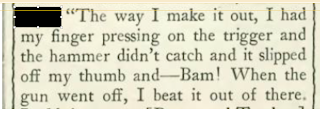This post is based on a two-part report by Croswell Bowen in the November 1 & 8 1952 issues of The New Yorker.
*
On September 7, 1948, Robert Brown killed a man. It was in the course of a hotel stick-up that his gun went off, the bullet striking the desk clerk, who fell dead on the spot.
Brown was twenty years old, an orphan whose father disappeared before he was born and whose mother was deemed unable to take care of him, and so Brown was shuffled off to foster homes. At school he was taunted by other students for being an orphan, and he took to stealing pennies to buy candy to appease his tormentors.
He never finished school, but eventually joined the Marine Corps, went AWOL, and was dishonorably discharged.
When he skipped out of the camp in Norfolk, Va., he headed back to New York City with a pistol he had stolen from another Marine.
Soon he was engaged in a series of stick-ups with a partner, then, after a sojourn at the Elmira Reformatory (having been apprehended), he jumped parole, and resumed robbery. Although he used a pistol in his crimes, he never resorted to violence. Acknowledging that he was a stick-up man, he denied being a killer. He told Croswell Bowen, the author of the New Yorker articles, about an earlier confrontation:
What happened on the night of the killing, though? Brown claimed,
*
Brown was swiftly apprehended in his apartment, offered no resistance, and, later, at the precinct house readily admitted to his guilt. The crime that he was accused of was classified as first-degree murder. Brown was facing the electric chair. Brown’s lawyers then attempted—to no avail—to persuade the two assistant district attorneys to reduce the charge to murder-two, which would spare Brown execution.
In the meantime, Brown was subjected to several psychiatric examinations to determine his sanity. All his life, Brown was fixated on the mother he had last known when he was less than three years old. He even thought that he could get enough money from his stick-ups to hire a detective agency to find her.
First to examine Brown was Dr. Fredric Wertham, who was called by the defense. After his examination of Brown, Dr.Wertham focused on two things: Brown’s mother fixation and the alleged noxious effect of comic books on the impressionable young man.*
Dr. Perry Lichtenstein, the District Attorney’s staff psychiatrist, also examined Brown, his conclusion countered Wertham’s: Brown, he claimed was legally sane. A third psychiatrist, Dr. Leo Orenstein, chief of the Psychiatric Clinic of the Court of General Sessions, had two meetings with Brown and agreed with Lichtenstein that Brown was legally sane.
So, Brown was to stand trial on the murder-one charge. A jury was seated, but before the trial began, in a surprise move, one of the assistant DAs said he had been debating with a defense lawyer whether it might not be possible "to save the boy's life." And so he recommended a reduced charge of murder-two.
Judge Saul S. Streit chose to believe Lichtenstein and Orenstein rather than Wertham on the matter of Brown’s sanity and then had to decide what sentence on the murder-two charge he should hand down. He stated:
And concluded that the sentence should be imprisonment for forty-five years to life.
Croswell Bowen ends his account of Robert Brown’s crime and punishment thus:
*
The case of Robert Brown interested me so much that I decided to try to find out more about him. I eventually turned up his obituary in The New York Times, which appeared on Sept. 24, 1994 under the heading “Robert Brown, 66; Ex-Convict Helped To Fight Prostitution.” Here, in part, is his obit:
With the help of a chaplain and a therapist, Mr. Brown rehabilitated himself while serving 23 years in state prisons. After his release in 1971, he became active in the Fortune Society, a self-help organization based in Manhattan that operates with public and private financing.
In the numerous talks that he gave to community groups on behalf of the society, he drew on his experiences to support his contention that the best way to combat violence was to prevent childhood abuse.
In 1978, he became an undercover investigator with the Mayor's Office of Midtown Enforcement, charged with gathering information on juvenile prostitution and pedophilia in Times Square. He walked the streets at night, unarmed, befriending young runaways. The vivid, detailed reports that he wrote helped to close a large number of businesses that served as fronts for prostitution in the area. He retired in 1989.
He then turned to writing an autobiography, which he did not finish. He described it as his story of deprivation and rehabilitation and the growth of a conscience.
*
Robert Brown was close to being killed by the State of New York. Thankfully, an assistant DA, deciding "to save the boy’s life," agreed to a murder-two charge.
Capital punishment is an abomination. Not only because of the many innocent souls murdered by the state, but also because, as Robert Brown’s case demonstrates, absent capital punishment, even the guilty may sometimes become honorable members of society.
***
* The alleged deleterious effects of comic books on youngsters was a hobbyhorse of Wertham’s. His most famous book was Seduction of the Innocent (1954). Nowadays, the complaints are about social media.













